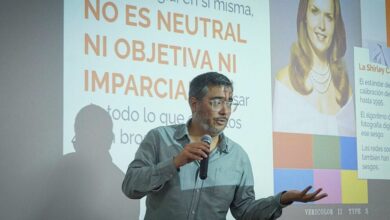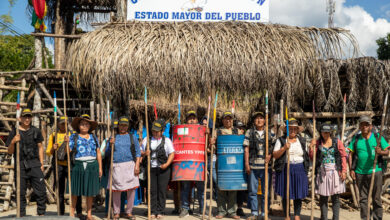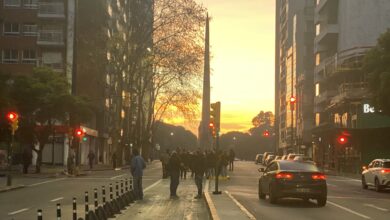Monaco Building: the last great symbol of drug trafficking?
Listen this article
The implosion of Pablo Escobar's former home destroyed with it a long history of terror in Medellín, a city that tries to promote new visions

In less than 10 seconds, several decades of history disappeared. The eight floors of the Monaco building, former residence of Pablo Escobar and his family, was demolished with the aim of leaving behind a part of the story and start telling another, different and closer to the victims. A before and after.
Leer en español: Edificio Mónaco: ¿el último gran símbolo del narcotráfico?
The demolition of this symbol of drug trafficking was interpreted as a tribute to the victims of drug violence. In fact, from the nearby Campestre Club of Medellin, some 1,600 people observed the collapse of the emblematic building, which was produced thanks to the nearly 3,000 holes for the injection of Indugel, an explosive material used by the company Atila Demoliciones, also in charge of the implosions in the recent past of the Space and Bernavento buildings.
According to El Colombiano, Colombia's president, Iván Duque, affirmed after the events that "This is a day in which we closed a dark chapter that marked our society. This building, symbol of that unhappy and terror-filled era, today falls to give way to a place where tribute is paid to the memory of the victims, the heroes who gave their lives to fight crime and, above all, who faced the terrible scourge of drug trafficking. Today the building falls and a hope begins".
In turn, Medellín's mayor, Federico Gutiérrez, said to the same media: " Under this sky we have had sad nights, dark nights, but we have also been supportive and resilient. Under this sky that looks at us today we have understood that the wind of oblivion can not take away the memory of our loved ones (…) Looking back at what many people preferred not to name is not easy, there is pain in words and also in silence (…) It is important to pay that narrative, social and institutional debt that we have with the new generations".
Read also: The Escobar’s curse: The heirs of the Colombian capo accused of money laundering
The FM also recalled that Monaco was a benchmark in relation to the first car bomb detonated in Colombia. In 1988, the Cali cartel attacked the structure, with Escobar and his family inside. That explosion affected the ears of the narco-trafficker's daughter, as well as his valuable collections of cars and art. Result: a bloody war between cartels.
In turn, El Tiempo adds that the Monaco building was made up of eight floors, was valued at 5 billion pesos, and included 34 parking spaces, 12 apartments, 2 swimming pools and a court.
Mayor Gutiérrez remains firm in his position to take advantage of the place and history, but in favor of the victims. In turn, the former mayor, Alonso Salazar, said: "The demolition is a step, but perhaps the claim and the voice of the victims is what can scare the ghost".
Even so, it is clear that the implosion of Monaco can not be the only step to leave behind the trace of Escobar. For example, in the same year the small plane with which he transported his first shipment of cocaine to the United States was removed from the Napoles Hacienda. This hacienda is now a recreational park.
There is still work to be done according to The FM. One of those works is the 443 houses that Escobar built for very humble families who lived in garbage dumps in Medellin, which earned him the nickname "Colombian Robin Hood", especially because many of them did not know the sources of his resources at that time.
BBC Mundo also intervenes in the issue with another focus, as it ensures that the disappearance of the emblematic building is also a blow to the so-called "narcoturismo", which is a business in the capital of the department of Antioquia and that has motivated the city to end definitely with any remaining symbol of Escobar.
Mauricio Builes Gil, professor at the Eafit University of Medellín, assures that the extinction of the Monaco building is an evolution, and that narco-terrorism will no longer be told only from the eccentricities and barbarism of its bosses, but from the point of view of the population that suffered with them. Currently, Builes Gil heads the project "Narcotour: the B side of drug trafficking"
The professor adds a very important detail for BBC World: "The mere fact of beginning to listen to the victims is an achievement of the city. We had to go through the fever of the soap operas, Netflix and that one of Escobar's hitmen became a youtuber for this to change".
What comes next?
After the implosion of the aforementioned Monaco building, the City Administration hopes that the place will continue to be visited, but no longer within the so-called 'Narcotours'. It is intended that they visit it as a representation of resilience, through a new building that will be called Inflexión (Inflection). This will aim to present as protagonists the victims of all the terror that was experienced; all these from three points of view: essence, inflection and resilience, reported El Tiempo.
The same article in El Tiempo gives a very important figure to understand Monaco Building's collapse. During the years of Escobar's supremacy, 46 thousand 200 victims were counted between 1983 and 1994. Therefore, a question that fits in this context is: how did this begin and what do we do so that it does not happen again?
Regarding this, César Augusto Zapata, collaborative advisor of the Mayor's Office for the creation of the memorial, explained that several Colombian artists will use the rubble to capture different artistic expressions. "It is important to leave the ruins because they show the new generations that something happened there, that there was something there. And that was the proposal of the designers," said the expert, who worked on the design New York's memorial in the United States, a construction in honor of the 911 victims, noted El Tiempo.
LatinAmerican Post | Onofre Zambrano
Translated from "Edificio Mónaco: ¿el último gran símbolo del narcotráfico?"





